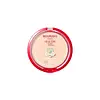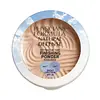Bourjois Paris Healthy Mix Powder Versus Physician's Formula Natural Defense Setting The Tone Finishing Powder SPF 20
What's inside
What's inside
 Key Ingredients
Key Ingredients

 Benefits
Benefits

 Concerns
Concerns

 Ingredients Side-by-side
Ingredients Side-by-side

Mica
Cosmetic ColorantKaolin
AbrasiveZinc Stearate
Cosmetic ColorantAvena Sativa Kernel Flour
AbrasiveIsopropyl Palmitate
EmollientOctyldodecyl Stearoyl Stearate
EmollientDimethicone
EmollientLauroyl Lysine
Skin ConditioningParfum
MaskingSorbitan Sesquioleate
EmulsifyingCaprylyl Glycol
Emollient1,2-Hexanediol
Skin ConditioningSodium Benzoate
MaskingTocopheryl Acetate
AntioxidantPunica Granatum Fruit Juice
MaskingEuterpe Oleracea Juice
Skin ConditioningAscorbyl Palmitate
AntioxidantPanthenol
Skin ConditioningGlycerin
HumectantWater
Skin ConditioningLycium Barbarum Fruit Extract
AstringentPantolactone
HumectantPotassium Sorbate
PreservativeCI 77891
Cosmetic ColorantIron Oxides
Mica, Kaolin, Zinc Stearate, Avena Sativa Kernel Flour, Isopropyl Palmitate, Octyldodecyl Stearoyl Stearate, Dimethicone, Lauroyl Lysine, Parfum, Sorbitan Sesquioleate, Caprylyl Glycol, 1,2-Hexanediol, Sodium Benzoate, Tocopheryl Acetate, Punica Granatum Fruit Juice, Euterpe Oleracea Juice, Ascorbyl Palmitate, Panthenol, Glycerin, Water, Lycium Barbarum Fruit Extract, Pantolactone, Potassium Sorbate, CI 77891, Iron Oxides
Titanium/Titanium Dioxide 5%
Cosmetic ColorantMica
Cosmetic ColorantCalcium Aluminum Borosilicate
Zinc Stearate
Cosmetic ColorantTricaprylin
MaskingBoron Nitride
AbsorbentDimethicone
EmollientLauroyl Lysine
Skin ConditioningDimethicone/Vinyl Dimethicone Crosspolymer
Skin ConditioningPhenoxyethanol
PreservativeParfum
MaskingCaprylyl Glycol
EmollientEthylhexylglycerin
Skin ConditioningHexylene Glycol
EmulsifyingAscorbyl Palmitate
AntioxidantBrassica Campestris/Aleurites Fordi Oil Copolymer
Skin ConditioningO-Cymen-5-Ol
AntimicrobialTocopheryl Acetate
AntioxidantWater
Skin ConditioningLecithin
EmollientPlankton Extract
Skin ConditioningIron Oxides
Titanium/Titanium Dioxide 5%, Mica, Calcium Aluminum Borosilicate, Zinc Stearate, Tricaprylin, Boron Nitride, Dimethicone, Lauroyl Lysine, Dimethicone/Vinyl Dimethicone Crosspolymer, Phenoxyethanol, Parfum, Caprylyl Glycol, Ethylhexylglycerin, Hexylene Glycol, Ascorbyl Palmitate, Brassica Campestris/Aleurites Fordi Oil Copolymer, O-Cymen-5-Ol, Tocopheryl Acetate, Water, Lecithin, Plankton Extract, Iron Oxides
 Reviews
Reviews

Ingredients Explained
These ingredients are found in both products.
Ingredients higher up in an ingredient list are typically present in a larger amount.
Ascorbyl Palmitate is created by combining pure Vitamin C and palmitic acid. It is an antioxidant and helps reduce hyperpigmentation.
This ingredient is a more stable version of Vitamin C, meaning it does not disintegrate as quickly when exposed to sunlight. However, studies show it does not penetrate skin as well as pure Vitamin C.
Ascorbyl Palmitate is oil soluble.
Read more about other types of Vitamin C:
Learn more about Ascorbyl PalmitateCaprylyl Glycol is a humectant and emollient, meaning it attracts and preserves moisture.
It is a common ingredient in many products, especially those designed to hydrate skin. The primary benefits are retaining moisture, skin softening, and promoting a healthy skin barrier.
Though Caprylyl Glycol is an alcohol derived from fatty acids, it is not the kind that can dry out skin.
This ingredient is also used as a preservative to extend the life of products. It has slight antimicrobial properties.
Learn more about Caprylyl GlycolDimethicone is a type of synthetic silicone created from natural materials such as quartz.
What it does:
Dimethicone comes in different viscosities:
Depending on the viscosity, dimethicone has different properties.
Ingredients lists don't always show which type is used, so we recommend reaching out to the brand if you have questions about the viscosity.
This ingredient is unlikely to cause irritation because it does not get absorbed into skin. However, people with silicone allergies should be careful about using this ingredient.
Note: Dimethicone may contribute to pilling. This is because it is not oil or water soluble, so pilling may occur when layered with products. When mixed with heavy oils in a formula, the outcome is also quite greasy.
Learn more about DimethiconeThis ingredient comes from a fatty acid (lauric acid) and amino acid (lysine). It is used to add a silky feel to cosmetics.
According to a manufacturer, its fatty acid base leaves a silky feeling on the skin. It also has emollient properties because of this. Emollients help soften skin by preventing water from evaporating.
Lauroyl lysine is barely soluble in water.
Learn more about Lauroyl LysineMica is a naturally occurring mineral used to add shimmer and color in cosmetics. It can also help improve the texture of a product or give it an opaque, white/silver color.
Serecite is the name for very fine but ragged grains of mica.
This ingredient is often coated with metal oxides like titanium dioxide. Trace amounts of heavy metals may be found in mica, but these metals are not harmful in our personal products.
Mica has been used since prehistoric times throughout the world. Ancient Egyptian, Indian, Greek, Roman, Aztec, and Chinese civilizations have used mica.
Learn more about MicaParfum is a catch-all term for an ingredient or more that is used to give a scent to products.
Also called "fragrance", this ingredient can be a blend of hundreds of chemicals or plant oils. This means every product with "fragrance" or "parfum" in the ingredients list is a different mixture.
For instance, Habanolide is a proprietary trade name for a specific aroma chemical. When used as a fragrance ingredient in cosmetics, most aroma chemicals fall under the broad labeling category of “FRAGRANCE” or “PARFUM” according to EU and US regulations.
The term 'parfum' or 'fragrance' is not regulated in many countries. In many cases, it is up to the brand to define this term.
For instance, many brands choose to label themselves as "fragrance-free" because they are not using synthetic fragrances. However, their products may still contain ingredients such as essential oils that are considered a fragrance by INCI standards.
One example is Calendula flower extract. Calendula is an essential oil that still imparts a scent or 'fragrance'.
Depending on the blend, the ingredients in the mixture can cause allergies and sensitivities on the skin. Some ingredients that are known EU allergens include linalool and citronellol.
Parfum can also be used to mask or cover an unpleasant scent.
The bottom line is: not all fragrances/parfum/ingredients are created equally. If you are worried about fragrances, we recommend taking a closer look at an ingredient. And of course, we always recommend speaking with a professional.
Learn more about ParfumTocopheryl Acetate is AKA Vitamin E. It is an antioxidant and protects your skin from free radicals. Free radicals damage the skin by breaking down collagen.
One study found using Tocopheryl Acetate with Vitamin C decreased the number of sunburned cells.
Tocopheryl Acetate is commonly found in both skincare and dietary supplements.
Learn more about Tocopheryl AcetateWater. It's the most common cosmetic ingredient of all. You'll usually see it at the top of ingredient lists, meaning that it makes up the largest part of the product.
So why is it so popular? Water most often acts as a solvent - this means that it helps dissolve other ingredients into the formulation.
You'll also recognize water as that liquid we all need to stay alive. If you see this, drink a glass of water. Stay hydrated!
Learn more about WaterZinc Stearate is the metal salt of stearic acid. It is a white solid used to bind, thicken, and lubricate products.
This ingredient is common in powder makeup, where it helps keep the powder together.
Zinc Stearate is hydrophobic and repels water.
This ingredient can be sourced from non-animal or animal sources. It is best to reach out to the brand to see where they source this ingredient from.
Learn more about Zinc StearateThis ingredient is a combination of red, black, and yellow iron oxide pigments. This combination of colors is usually found in foundation, because it results in a "skin" color.